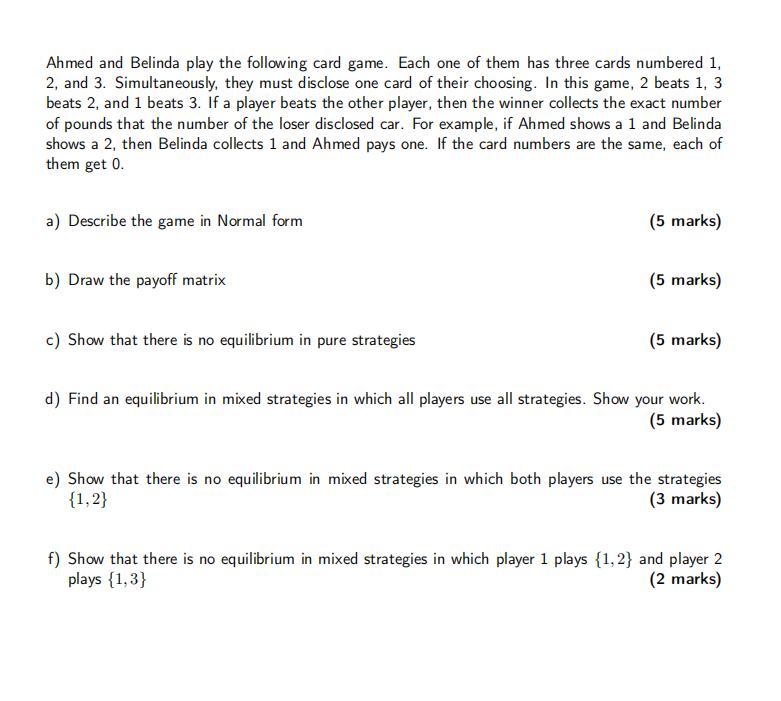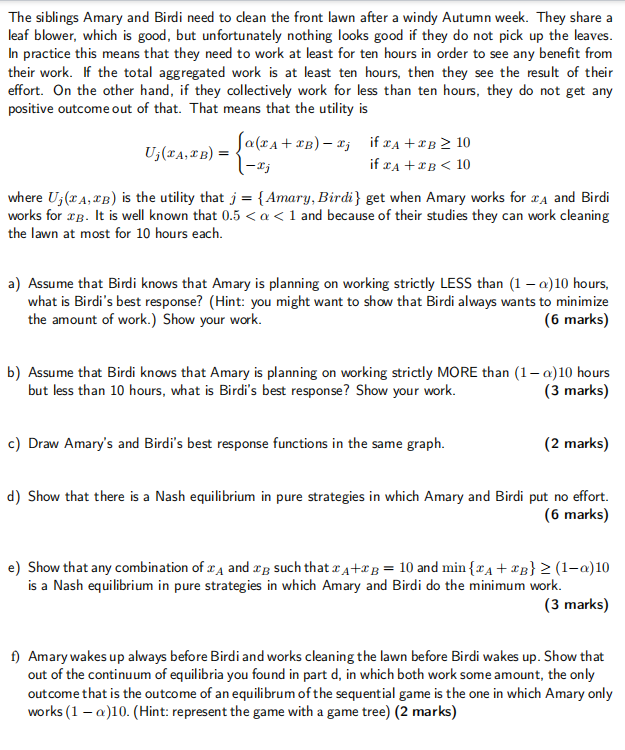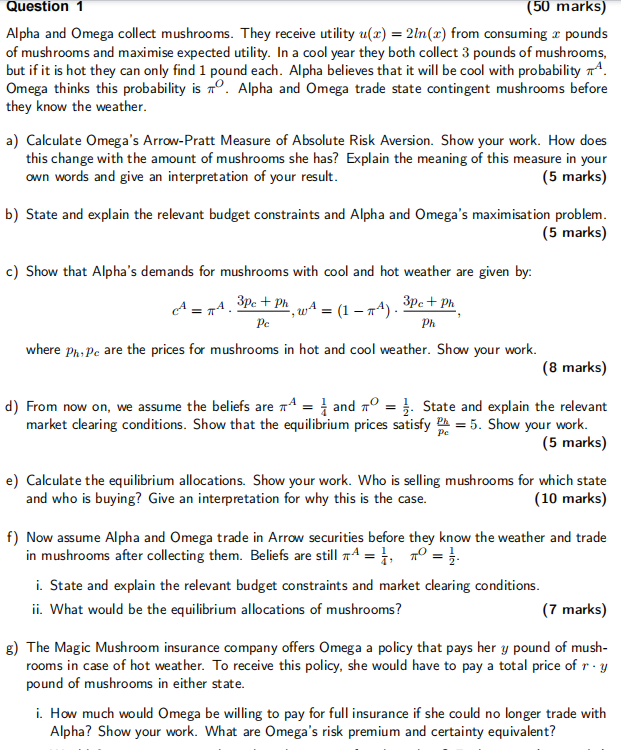Answered step by step
Verified Expert Solution
Question
1 Approved Answer
Ahmed and Belinda play the following card game. Each one of them has three cards numbered 1, 2, and 3. Simultaneously, they must disclose



Ahmed and Belinda play the following card game. Each one of them has three cards numbered 1, 2, and 3. Simultaneously, they must disclose one card of their choosing. In this game, 2 beats 1, 3 beats 2, and 1 beats 3. If a player beats the other player, then the winner collects the exact number of pounds that the number of the loser disclosed car. For example, if Ahmed shows a 1 and Belinda shows a 2, then Belinda collects 1 and Ahmed pays one. If the card numbers are the same, each of them get 0. a) Describe the game in Normal form b) Draw the payoff matrix (5 marks) (5 marks) (5 marks) c) Show that there is no equilibrium in pure strategies d) Find an equilibrium in mixed strategies in which all players use all strategies. Show your work. (5 marks) e) Show that there is no equilibrium in mixed strategies in which both players use the strategies {1,2} (3 marks) f) Show that there is no equilibrium in mixed strategies in which player 1 plays {1,2} and player 2 plays {1,3} (2 marks) The siblings Amary and Birdi need to clean the front lawn after a windy Autumn week. They share a leaf blower, which is good, but unfortunately nothing looks good if they do not pick up the leaves. In practice this means that they need to work at least for ten hours in order to see any benefit from their work. If the total aggregated work is at least ten hours, then they see the result of their effort. On the other hand, if they collectively work for less than ten hours, they do not get any positive outcome out of that. That means that the utility is Ja(A+B); if +B 10 U(A, B)= = -xj if x + xB < 10 where Uj (A, B) is the utility that j = {Amary, Birdi} get when Amary works for A and Birdi works for B. It is well known that 0.5 < a < 1 and because of their studies they can work cleaning the lawn at most for 10 hours each. a) Assume that Birdi knows that Amary is planning on working strictly LESS than (1 - a) 10 hours, what is Birdi's best response? (Hint: you might want to show that Birdi always wants to minimize the amount of work.) Show your work. (6 marks) b) Assume that Birdi knows that Amary is planning on working strictly MORE than (1 - a) 10 hours but less than 10 hours, what is Birdi's best response? Show your work. c) Draw Amary's and Birdi's best response functions in the same graph. (3 marks) (2 marks) d) Show that there is a Nash equilibrium in pure strategies in which Amary and Birdi put no effort. (6 marks) e) Show that any combination of A and B such that A+B = 10 and min {A+B} (1-) 10 is a Nash equilibrium in pure strategies in which Amary and Birdi do the minimum work. (3 marks) f) Amary wakes up always before Birdi and works cleaning the lawn before Birdi wakes up. Show that out of the continuum of equilibria you found in part d, in which both work some amount, the only outcome that is the outcome of an equilibrum of the sequential game is the one in which Amary only works (1-a)10. (Hint: represent the game with a game tree) (2 marks) Question 1 (50 marks) Alpha and Omega collect mushrooms. They receive utility u(x) = 2ln(x) from consuming a pounds of mushrooms and maximise expected utility. In a cool year they both collect 3 pounds of mushrooms, but if it is hot they can only find 1 pound each. Alpha believes that it will be cool with probability T^. Omega thinks this probability is . Alpha and Omega trade state contingent mushrooms before they know the weather. a) Calculate Omega's Arrow-Pratt Measure of Absolute Risk Aversion. Show your work. How does this change with the amount of mushrooms she has? Explain the meaning of this measure in your own words and give an interpretation of your result. (5 marks) b) State and explain the relevant budget constraints and Alpha and Omega's maximisation problem. (5 marks) c) Show that Alpha's demands for mushrooms with cool and hot weather are given by: 3pc + Ph Pc ,w = (1 ^). 3Pc+Ph Ph where Ph. Pe are the prices for mushrooms in hot and cool weather. Show your work. (8 marks) d) From now on, we assume the beliefs are = and = . State and explain the relevant market clearing conditions. Show that the equilibrium prices satisfy P = 5. Show your work. Pe (5 marks) e) Calculate the equilibrium allocations. Show your work. Who is selling mushrooms for which state and who is buying? Give an interpretation for why this is the case. (10 marks) f) Now assume Alpha and Omega trade in Arrow securities before they know the weather and trade in mushrooms after collecting them. Beliefs are still = 1, = }} i. State and explain the relevant budget constraints and market clearing conditions. ii. What would be the equilibrium allocations of mushrooms? (7 marks) g) The Magic Mushroom insurance company offers Omega a policy that pays her y pound of mush- rooms in case of hot weather. To receive this policy, she would have to pay a total price of ry pound of mushrooms in either state. i. How much would Omega be willing to pay for full insurance if she could no longer trade with Alpha? Show your work. What are Omega's risk premium and certainty equivalent?
Step by Step Solution
There are 3 Steps involved in it
Step: 1

Get Instant Access to Expert-Tailored Solutions
See step-by-step solutions with expert insights and AI powered tools for academic success
Step: 2

Step: 3

Ace Your Homework with AI
Get the answers you need in no time with our AI-driven, step-by-step assistance
Get Started


